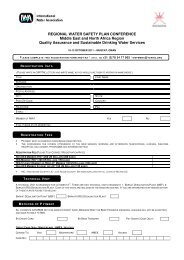Water safety in buildings - libdoc.who.int - World Health Organization
Water safety in buildings - libdoc.who.int - World Health Organization
Water safety in buildings - libdoc.who.int - World Health Organization
Create successful ePaper yourself
Turn your PDF publications into a flip-book with our unique Google optimized e-Paper software.
3 Roles and responsibilities<br />
This section describes the roles of stakeholders and other responsible personnel to ensure<br />
that the water supply is safe. Many people are <strong>in</strong>volved <strong>in</strong> water <strong>safety</strong>, from the <strong>in</strong>itial<br />
water planners to ongo<strong>in</strong>g operation and ma<strong>in</strong>tenance providers, and their range of duties<br />
is illustrated <strong>in</strong> this section.<br />
3.1 Background<br />
A large number of stakeholders can <strong>in</strong>fluence the <strong>safety</strong> of water systems with<strong>in</strong> build<strong>in</strong>gs.<br />
These stakeholders can be <strong>in</strong>volved <strong>in</strong> the plann<strong>in</strong>g, design, construction and renovation<br />
of build<strong>in</strong>gs, as well as development of water <strong>safety</strong> plans (WSPs), and the ongo<strong>in</strong>g<br />
ma<strong>in</strong>tenance and operation of water systems. The specific titles of stakeholders and<br />
divisions of responsibilities will vary between different countries and jurisdictions, but<br />
the broad range of tasks will rema<strong>in</strong> fairly consistent. Figures 3.1–3.3 (at the end of this<br />
section) provide examples of roles and responsibilities <strong>in</strong> one jurisdiction.<br />
Stakeholders can <strong>in</strong>clude:<br />
• build<strong>in</strong>g commissioners <strong>who</strong> are <strong>in</strong>volved before construction of new build<strong>in</strong>gs or<br />
renovation of exist<strong>in</strong>g build<strong>in</strong>gs, such as developers, plann<strong>in</strong>g officers, architects,<br />
design eng<strong>in</strong>eers, builders, plumbers, manufacturers and suppliers;<br />
• build<strong>in</strong>g operators, <strong>in</strong>clud<strong>in</strong>g build<strong>in</strong>g managers and owners, tenants and employers;<br />
• employees, residents and users of build<strong>in</strong>gs;<br />
• service providers and specialist consultants <strong>who</strong> provide technical assistance, such as<br />
plumbers, ma<strong>in</strong>tenance contractors, water-treatment specialists, risk assessors and<br />
auditors;<br />
• professional bodies <strong>who</strong> develop guidance and tra<strong>in</strong><strong>in</strong>g;<br />
• <strong>in</strong>fection-control personnel <strong>in</strong> dental and medical facilities, and <strong>in</strong>fection-control<br />
teams <strong>in</strong> hospitals and health-care facilities;<br />
• regulators responsible for oversight of build<strong>in</strong>g and plumb<strong>in</strong>g codes, public health<br />
requirements and occupational health and <strong>safety</strong>;<br />
• public health and environmental health officials;<br />
• standard-sett<strong>in</strong>g bodies and certification agencies;<br />
• tra<strong>in</strong><strong>in</strong>g providers;<br />
• providers of laboratory services.<br />
17


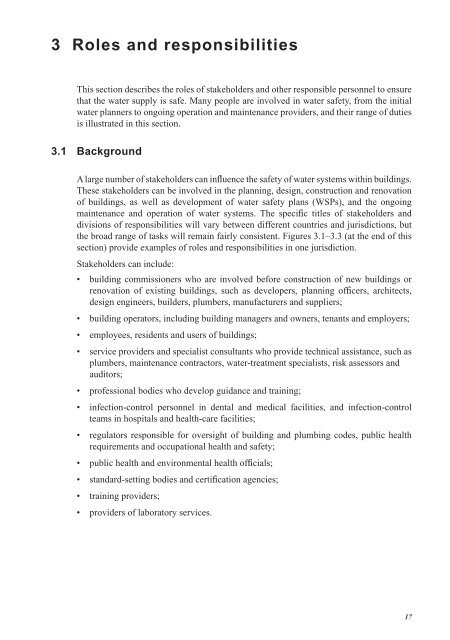
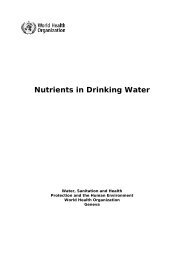
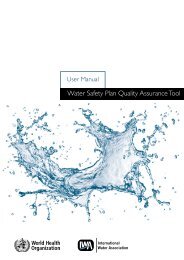

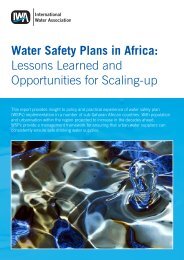

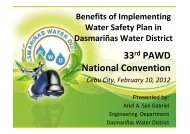
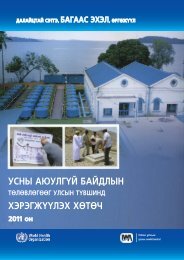

![Pdf [5.32 Mb] - Water Safety Portal](https://img.yumpu.com/32098467/1/190x245/pdf-532-mb-water-safety-portal.jpg?quality=85)
